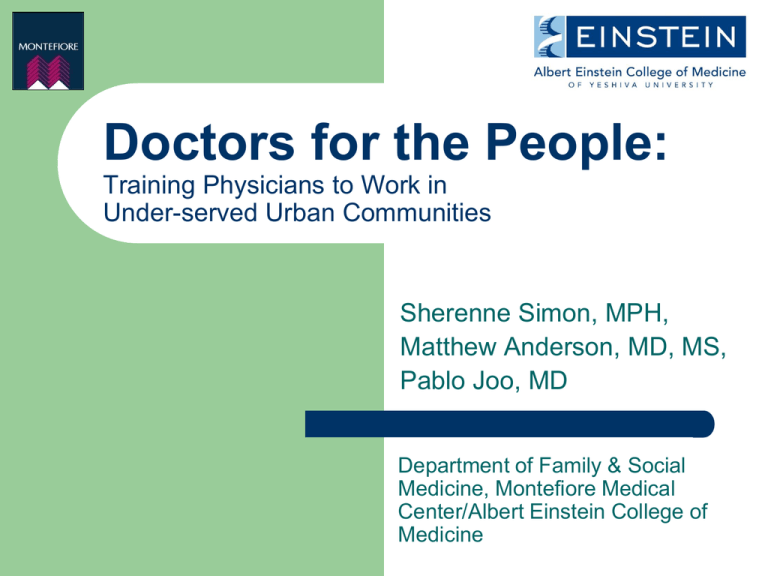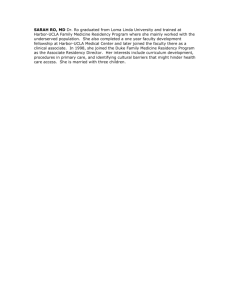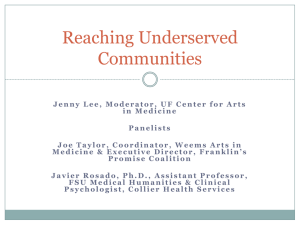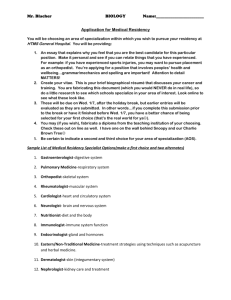training physicians to work in underserved urban communities
advertisement

Doctors for the People: Training Physicians to Work in Under-served Urban Communities Sherenne Simon, MPH, Matthew Anderson, MD, MS, Pablo Joo, MD Department of Family & Social Medicine, Montefiore Medical Center/Albert Einstein College of Medicine Project Aim Montefiore’s Residency Program in Social Medicine (RPSM), established in 1970, trains clinicians to work in underserved communities. In order to improve our own work we set about to examine similar programs which train clinicians to work in underserved communities. Why do we need such programs? Higher Education is funded and organized by the US ruling class: – – – – Weill-Cornell Medical School Charles H. Greenberg Pavilion @ NYH Belfer Building @ AECOM Interlocking corporate academic directorships Medical Students are a very privileged group. Contextual Factors Well recognized problem for rural areas US government has attempted to address through HRSA, NHSC Literature on financial incentives and specific curricular elements Efforts going on at the undergraduate level: – High School, College, Post-baccalaureate Locating Programs Google Search for websites; Google Scholar for articles Snow-balling technique (referrals) HRSA funded programs (1999-2000) to promote Primary Care Literature Review Inclusion Criteria – – – Medical Schools & Residency Programs Mission to accept minority/working class students and/or train for underserved communities Published literature about program outcomes Exclusion criteria: – – – High School or College enrichment programs Rural Programs Traditionally African American Medical Schools Interviews (phone/email/website) How and why program was created How the program is financed and its cost to students Educational philosophy & curriculum Recruitment & retention policies Evaluation methods of graduates long term success & programmatic success Relationship to more traditional training programs Barriers and successes Medical Schools Sophie Davis School of Biomedical Engineering (CUNY) Charles R. Drew Program (UCLA) UC/PRIME programs (5 programs - 1 is rural) A.T. Still University School of Osteopathic Medicine (SOMA) Baylor College (Texas) Residency Programs (sample) Arizona University of Arizona Family & Community Medicine California UCLA/Harbor Family Medicine Residency UCSF/San Francisco General Hospital: Family & Community Medicine Florida University of Miami/Jackson Memorial Family Medicine & Community Health Miller School of Medicine: Jay Weiss Residency in Global Health Equity & Internal Medicine. Also at Jackson Memorial Residency Programs (sample) Illinois Cook County Internal Medicine Primary Care Maryland Johns Hopkins Bloomberg School of Public Health, General Preventive Medicine Residency (PM) Massachusetts U Mass, Worcester: Family Medicine & Community Health Lawrence Family Medicine Residency Residency Programs (sample) New York Residency Program in Social Medicine (FM,IM,PED) Washington University of Washington, Tacoma Family Medicine Justifications offered by programs US population increasingly diverse Minority/working class students face growing barriers getting into medical school Geographical maldistribution of physicians: both urban & rural Minority and working class populations have worse health care access & outcomes (health disparities) Structure of Programs Medical school programs typically associated with traditional MS, but offer enhanced curriculum (ie. disparities, community health) Training often occurs in community settings, particularly community health centers Service training sites are in underserved areas Requirement for research/paper/project/Masters degree Special mentorship Educational Philosophy Emphasis on Primary Care Work in communities, specifically underserved communities Work in Community Health Centers Recruitment/Retention Pairing with college-level pipeline programs Trainees expected to share program vision of working in underserved communities Special mentorship & assistance Methods of evaluation within programs Racial/Ethnic/Class composition of trainees (or) graduates Intention vs. actual practice in underserved communities Practice in primary care Traditional academic metrics: board scores, specialization rates; graduates who are faculty or involved in public health administration Evaluation Techniques Use of AAMC survey data on where students intend to practice – Measured at 3 time points: MCAT, entrance and exit to medical school AMA master file of clinicians to determine practice sites of graduates HPSA (Health Professional Shortage Areas) Follow-up surveys of trainees – Such surveys are uncommon and cost money Evaluation: Charles R. Drew Medical Education Program Ko M, Edelstein RA, Heslin KC, Rajagopalan S, Wilkerson L, Colburn L, et al. Impact of the University of California, Los Angeles/Charles R. Drew University medical education program on medical students' intentions to practice in underserved areas. Acad Med. 2005 Sep;80(9):803-8. Outcomes Programs report high levels of training minority and/or working class physicians High level of work by graduates in primary care and underserved areas Successful academic outcomes Caveats Those who make it to medical school are the “lucky few.” Selection bias: Students entering these programs know what they are getting into What are appropriate comparison groups for these programs? These programs are all small, almost “boutique” programs Caveats (Contextual issues) We are losing this battle now…. – – Barriers to getting into medical school appear to have increased since the 1990’s. Decreasing number of US students choose primary care. These programs rely on funding for Primary Care training programs (Title VII) A mission to serve the underserved does not currently characterize most of US academic medicine (neither does an interest in PC) Conclusions Successful programs exist that train clinicians to work in underserved communities. Shared elements – – – Mission to serve the underserved (caveat: this was a selection criteria) Training in underserved communities. Community & Primary Care orientation These findings are similar to those in rural health programs. Next Steps/Discussion points How might this project inform our own work? What are its broader implications for academic medical institutions? – Is the medical school responsible for the composition of its classes & the future careers of its doctors? What are the broader implications for US education if professional careers are unavailable to large sections of the population? Thank You Contacts: Matthew Anderson, MD, MS bronxdoc@gmail.com


